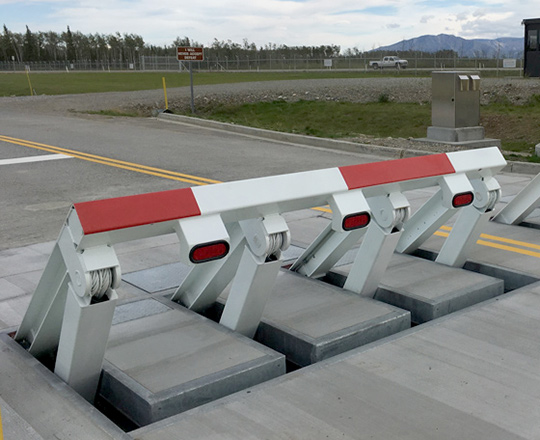About Wedge Barriers
Table of ContentsGet This Report about Wedge BarriersSome Known Incorrect Statements About Wedge Barriers

Indicators on Wedge Barriers You Should Know
g., springtime support 65 )might be taken care of to the end of the spring pole 58 to allow compression of the springs 60. As the springtimes 60 are compressed in between the spring supports 62, the springtime assembly 54 produces a force acting on the web cam paired to the spring pole 58 in a direction 66. The staying force used to
the cam webcam deploy release wedge plate 16 may be provided given an electromechanical actuator 84 or other actuator. The spring setting up 54 and the actuator 84(e. g., electromechanical actuator)may run together to equate the web cam and lift the wedge plate 16.
As discussed above, the springtime assembly 54 exerts a consistent force on the cam, while the electromechanical actuator might be regulated to put in a variable force on the web cam, consequently allowing the lifting and reducing( i. e., releasing and retracting )of the wedge plate 16. In specific personifications, the constant force used by the springtime assembly 54 might be adjustable. g., electromechanical actuator) is handicapped. As will be appreciated, the spring assembly 54 may be covered and shielded from particles or various other elements by a cover plate(e. g., cover plate 68 displayed in FIG. 4) that may be significantly flush with the raised surface area 38 of the structure 14. As stated over, in the released position, the wedge plate 16 serves to obstruct accessibility or travel beyond the barrier 10. As an example, the barrier 10(e. g., the wedge plate 16 )may block pedestrians or vehicles from accessing a property or path. As talked about above, the obstacle 10 is affixed to the support 30 safeguarded within the structure 14,

front braces 71. As a result, the linkage settings up 72 might pivot and revolve to enable the collapse and extension of the link settings up 72 throughout retraction and deployment of the bather 10. The link settings up 72 cause motion of the wedge plate 16 to be limited. If a lorry is traveling in the direction of the deployed wedge plate 16(e. For example, in one scenario, the safety and security legs 86 may be prolonged throughoutmaintenance of the barrier 10. When the security legs 86 are released, the security legs 86 support the weight of the wedge plate 16 against the surface 12. Because of this, the lifting mechanism 50 may be shut off, serviced, eliminated, replaced, and so forth. FIG. 5 is partial perspective view of an embodiment of the surface-mounted wedge-style barrier 10, illustrating the webcam 80 and the webcam surfaces 82 of the lifting device 50. Especially, 2 web cam surface areas 82, which are described as reduced web cam surface areas 83, are placed listed below the camera 80. The reduced cam surfaces 83 may be dealt with to the surface 12 (e. For example, the lower web cam surface areas like this 83 and the mounting plate 85 might form a single item that is secured to the support 30 by screws or other mechanical bolts. Furthermore, two camera surfaces 82, which are described as top web cam surface areas 87, are placed above the camera 80 and paired to (e. In various other embodiments, stepping in layers or plates may be placed between the surface area 12 and the reduced web Wedge Barriers cam surfaces 83 and/or the wedge plate 16 and the upper camera surfaces 87 As discussed above, the web cam
80 equates along the web cam surface areas 82 when the wedge plate 16 is raised from the retracted placement to the released position. In addition, as discussed over, the spring assembly 54 (see FIG. 3 )may offer a pressure acting on the web cam 80 in the instructions 102 via spring pole 58, which might reduce the force the electromechanical actuator 84 is required to relate to the web cam 80 in order to activate and raise the wedge plate 16. 1 )to the released position(see FIG. 4). As shown, the web cam 80 includes track wheels 104(e. g., rollers), which get in touch with and equate along the webcam surfaces 82 during procedure.